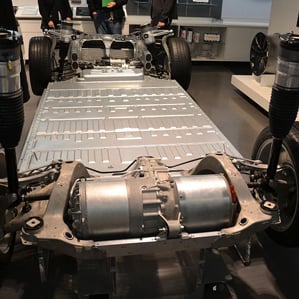Panasonic Agrees to Help Tesla Build Its Gigafactory
Tesla Motors says it has reached an agreement with Panasonic, a major lithium-ion battery supplier based in Japan, to help the electric car maker build a previously announced massive battery factory. The factory, which Tesla calls a gigafactory, is expected to be able to produce more batteries than all current lithium-ion battery factories combined.

Tesla has been talking about the factory for months, but its fate depends on the electric car maker getting the support of suppliers, who will provide the majority of funding and technical know-how. The agreement with Panasonic could be a major win for Tesla, since Tesla doesn’t have the expertise to build many of the parts of a battery pack. Tesla declines to provide details about how much Panasonic will invest. The announcement also stopped short of saying where the factory will be built or when construction will start. In previous announcements Tesla has said that the factory will cost $5 billion, with $2 billion coming from Tesla and the rest from partners.
The gigafactory is Tesla’s attempt to drive down the cost of the battery packs—the most expensive part on an electric car and the major reason electric cars cost more than conventional ones. It says the factory will lower costs by 30 percent, both through economies of scale and by locating multiple suppliers under one roof, which will decrease costs for transporting and packaging parts.
Tesla says the battery cost reduction will be enough to allow it to make a new electric car that will cost about $35,000 and travel about 200 miles on a charge. The cheapest Model S, Tesla’s existing car, costs $70,000, with more expensive models running well over $100,000. The car travels 265 miles on a charge.
The factory is also meant to secure the large number of batteries Tesla will need if it is to meet its goal of selling hundreds of thousands of cars a year. By 2020, the factory is supposed to produce enough batteries for 500,000 electric cars per year. Tesla seems to be counting on sales of the lower price Model 3 to hit those numbers. Last year Tesla only delivered 22,477 cars, and has said it is on track to deliver 35,000 cars in 2014. In a shareholder letter released this afternoon, Tesla said it expects to deliver 100,000 cars per year by the end of next year.
Currently Tesla’s batteries involve work in many separate facilities—such as factories for processing different battery materials, for assembling those into individual battery cells, and finally for assembling thousands of cells, together with electronics and cooling systems, into a complete battery pack. For its current vehicles Tesla has been buying cells from Panasonic and assembling them into packs itself.
Under the new agreement, Tesla will build the factory building, and Panasonic will set up shop inside it, buying the needed equipment and manufacturing cells in about half of the factory space. The rest of the space will be occupied by Tesla, which will continue to assemble the cells to make complete battery packs, as well as other suppliers who will produce the materials and other components needed to make battery packs.
Some experts are skeptical that there will be enough demand for electric cars to justify the size of the gigafactory (see “Does Musk’s Gigafactory Make Sense?”). That’s set off speculation that the factory might also provide batteries for purposes other than powering cars, such as storing solar energy. In a statement today, Tesla CTO JB Straubel lent some credence to these speculations by saying that the factory will reduce the cost of energy storage “across a broad range of applications.”
Updated at 4:50 pm to reflect information in the Tesla shareholder letter.
Keep Reading
Most Popular
Large language models can do jaw-dropping things. But nobody knows exactly why.
And that's a problem. Figuring it out is one of the biggest scientific puzzles of our time and a crucial step towards controlling more powerful future models.
The problem with plug-in hybrids? Their drivers.
Plug-in hybrids are often sold as a transition to EVs, but new data from Europe shows we’re still underestimating the emissions they produce.
Google DeepMind’s new generative model makes Super Mario–like games from scratch
Genie learns how to control games by watching hours and hours of video. It could help train next-gen robots too.
How scientists traced a mysterious covid case back to six toilets
When wastewater surveillance turns into a hunt for a single infected individual, the ethics get tricky.
Stay connected
Get the latest updates from
MIT Technology Review
Discover special offers, top stories, upcoming events, and more.